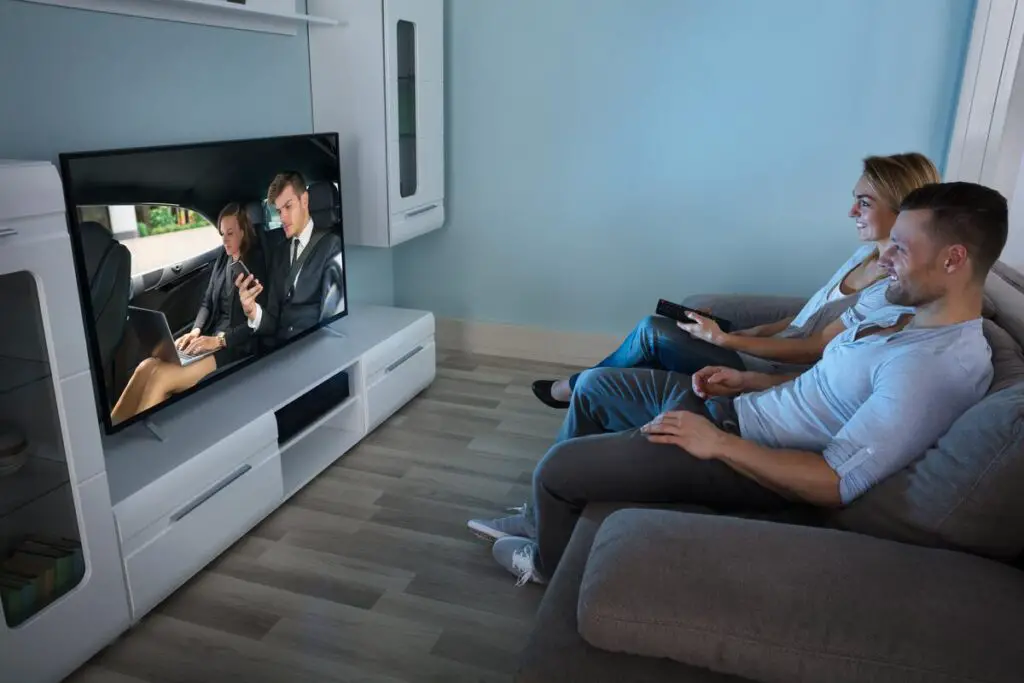5 Smart TVs With Dolby Vision And HDR10+
Disclosure: Tech Parasol is supported by its readers. When you purchase through links on our site, we may earn an affiliate commission. Thank you.
HDR or High Dynamic Range arguably has a bigger visual impact than resolution and is a “must-have” technology when you’re in the market for a new Smart TV.
HDR dramatically improves color reproduction and contrast and allows for more detailed images, particularly in shadowy areas.
Not all TVs support all HDR formats. But the TVs we have below all support HDR10+ and Dolby Vision formats.
This means you won’t have to worry about what format your favorite content is in before streaming it.
Here are our picks for Smart TVs that have Dolby Vision and HDR10+.

Hisense U6G
The Hisense U6G performs great in light and dark rooms, particularly when watching HDR content. It’s very affordable and should please most users.
Here’s what else you can expect:
- Supports HDR10, HDR10+, Dolby Vision and HLG.
- Out of the box, the U6G performs well in dark rooms thanks to its VA panel which has a high native contrast ratio.
- The U6G has a decent full-array dimming feature which improves picture quality in dark scenes and has minimal blooming around bright objects.
- Although it has a great response time and low input lag, it lacks gaming features like HDMI 2.1, Variable Refresh Rate (VRR) and eARC.
- The U6G has narrow viewing angles, so isn’t the best for watching content in wide seating areas or with a large group of people.
- It comes with Android TV and has a huge selection of streaming apps.
- Has four HDMI 2.0 ports for connecting a variety of devices and has support for HDMI ARC.
Hisense U8G
The U8G is a great gaming TV with low input lag and fast response time.
It also has impressive performance for general use with high peak brightness, great contrast ratio, excellent local dimming and an excellent color gamut.
The only downside is the narrow viewing angles, which is an issue for all VA-panel TVs.
But if you’re viewing the TV straight on, then this won’t be a problem.
Here are main features:
- Supports HDR10, HDR10+, Dolby Vision and HLG.
- Has two HDMI 2.1 ports
- Has low input lag, excellent response time and VRR for an excellent gaming TV.
- Delivers outstanding contrast and produces deep blacks using the VA-type panel.
- The U8G has an impressive peak brightness and performs well when displaying HDR content.
- Handles reflections very well, so great for use in bright rooms.
- The U8G can display 4K @ 120Hz signals for smooth and responsive gaming.
- The U8G also runs Android 10, which is much smoother and faster than Android 9.0 that was installed on previous 2019 models.
- Build quality is excellent with tracks and clips on the back of the TV so you can keep the cables hidden and tidy.
Vizio M7 Series Quantum 2021
The M7 Series is good overall but is a great gaming TV that has support for VRR (FreeSync) and has a quick response time and low input lag for responsive gaming.
The Vizio M7 Series provides excellent value with features such as local dimming and VRR.
It’s not the brightest TV, but it’s bright enough to bring out some of the highlights in HDR.
Another downside is that it doesn’t have HDMI 2.1, so if you want 120fps gaming, you may want to consider the Hisense U8G instead (above).
Here’s what else you need to know:
- Supports HDR10, HDR10+, Dolby Vision and HLG.
- Well built and comes in a wide range of sizes.
- Supports FreeSync VRR but not G-SYNC compatible.
- Input lag is very low for responsive gaming.
- The Vizio M7 Series is limited to 4K gaming at 60fps rather than 120 fps since it doesn’t have any HDMI 2.1 ports. It does have four HDMI 2.0 ports though and one of them supports ARC.
- Has a full-array local dimming feature but does cause some blooming.
- Not very well suited to wide seating arrangement due to poor viewing angles.
- Has a VA type panel which delivers a fantastic native contrast ratio for deep blacks and is therefore best suited to watching movies in dark rooms.
- Has an excellent color gamut and is able to produce deep and saturated reds, greens and blues. The TV also handles color gradients well without banding.
- Has a built-in SmartCast system allowing you to cast anything from your phone using Google Chromecast or Apple AirPlay.
Panasonic JZ2000
The Panasonic JZ2000 makes no compromises at all and is as premium as you can get when it comes to an OLED TV.
It’s HDR performance is one of the best, if not, the best on the market. It’s super bright and has a Dolby Atmos sound system that sounds as good as a soundbar.
It’s closest rival is probably the Sony A90J, but the LG G1 comes pretty close too – it’s just not as bright.
With the custom 4K OLED panel and 125W of Dolby Atmos speakers, the JZ2000 will give you an all-in-one home cinema experience that’s hard to beat.
The only downside is that Panasonic doesn’t sell TVs in North America or Australia.
- Support for HDR10+ Adaptive and Dolby Vision.
- Super bright OLED screen (more than 900 nits in normal viewing mode) that shows huge amounts of detail.
- Color accuracy is second to none.
- Supports 4K at 120Hz on inputs 1 and 2 including Variable Refresh Rate.
- All four HDMI 2.1 ports support Auto Low Latency Mode game mode.
- Comes with a Dolby Atmos sound system that rivals many soundbars. Has a seven-channel sound system, plus subwoofer that produces 125W in total.
- eARC support for soundbars.
- Supports dual bluetooth connection allowing the TV to transmit to two separate bluetooth devices at the same time.
- The HCX Pro AI processor analyses each frame and recognizes genres to further optimize the picture. It does this with audio too and in real-time.
Philips 65OLED806
The Philips OLED806 is a superb TV with a wide range of features that gamers will love.
It uses a conventional OLED panel from LG to deliver 4K pictures at 120Hz. Color accuracy is excellent and general colors look cinematic and natural.
On top of that, it’s great value for money, supports all HDR formats, supports HDMI 2.1 and has four-sided Ambilight.
The downside is that the chassis is pretty deep, so not really designed to be wall mounted.
It also requires some tweaks to the settings to get the optimum picture.
Here are its main features:
- HDR10, HLG, HDR10+ and Dolby Vision IQ all supported. HDR10+ Adaptive is supported too.
- Has two HDMI 2.1 ports which use 48Gbps sockets. Supports 4K@120Hz, VRR in all formats (G-Sync certification in progress) and ALLM (Auto Low Latency Mode) and 14ms input lag.
- One downside is that one of the HDMI 2.1 ports support eARC, preventing the use of two games consoles and connection to a soundbar/receiver at the same time.
- Standard ARC is supported on the other two HDMI sockets.
- Runs the Android 10 platform.
- The OLED806 has two tuners, three USB ports, dual-band Wi-Fi and Bluetooth 5.0
Sources
Hisense U6G Review (50U6G, 55U6G, 65U6G, 75U6G)
The 5 Best 4k HDR TVs – Fall 2021: Reviews
The 5 Best 4k Gaming TVs – Fall 2021: Reviews
Hisense U8G Review (55U8G, 65U8G)
Panasonic JZ2000 review (TX-55JZ2000): an astounding OLED 4K TV gets even better
Panasonic JZ2000 4K OLED TV review
Philips 65OLED806 OLED TV review

Robert Anderson
Robert Anderson, the founder of Tech Parasol, had a keen interest in tech from a very young age. He studied Electronic Engineering at University and then went on to become a Software Developer. He launched Tech Parasol in 2021 to share his knowledge with the aim of making tech easier to understand for everyone.

